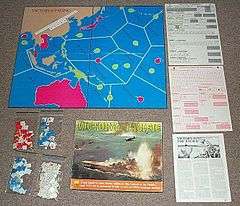Victory in the Pacific
 | |
| Designer(s) | Richard Hamblen |
|---|---|
| Publisher(s) | Avalon Hill |
| Publication date | 1977 |
| Genre(s) | Board wargame |
| Players | 2 |
| Age range | 12 and up |
Victory in the Pacific is a board wargame published by the Avalon Hill game company in 1977. Based on the game system first used in War at Sea, also published by Avalon Hill, the game deals with the Pacific Theater of Operations of World War II. A two-player game that can last up to five hours, each turn represents about six months, and units typically represent armies, air forces, and capital ships (aircraft carriers, battleships, battlecruisers, heavy cruisers, and light cruisers) of the United States Navy, Royal Navy, Dutch Navy, and Imperial Japanese Navy.
The board divides the Pacific Ocean into 13 sea zones. Each turn players commit their ship, air, and amphibious units to particular zones, and then (if there are opposing forces in the same area) a battle is fought in each zone, until one player retreats or is eliminated. Points of control (POC) are earned based on how many zones a player controls in that turn. Certain areas are worth more to one or both players than others. For example, the Japanese (IJN) player receives 3 POC for controlling Indonesia or the Japanese Islands, but only 1 for controlling the North Pacific. The Allied (USN) player receives only 1 POC for Indonesia, but 3 for the Hawaiian Islands.
One of the most basic strategic decisions in the game is which ships to use as "patrollers" and which to use as "raiders". Patrollers are deployed first, then land-based air, then amphibious units, and then raiders. So, saving ships for use as raiders allows a player to see a much more developed situation before committing ships, as well as allowing them to travel farther across the map. However, raiding ships do not count for "control" of an area as patrolling ships (and all land-based air flotillas) do, so some ships usually must be committed early to gain key POC — or to cut off enemy sea access because on the next turn, enemy ships will not be able to move through a controlled area although they may move into one.
Each side receives reinforcements throughout the game approximately coinciding to when the specific ships either became battle-ready in the actual war, or in the case of some Allied ships, were transferred in from the Atlantic theater. The IJN receives most of its ships at the beginning of the game, with only a few reinforcements, while the United States' shipyards churn out ship after ship. At the beginning of Turn 6 the Allied player receives massive US carrier reinforcements which shift the fleet balance dramatically and force the Japanese into a defensive posture. However, in the first 5 turns the IJN's larger fleet usually runs up a large POC advantage which even the USN's newly enlarged fleet may be hard-pressed to overcome in only 3 turns. This is somewhat mitigated because the Allied player (because the USA broke the Japanese code) gets to move second in every phase, e.g. he can wait to see where the IJN raiders are placed before placing his own raiders, and in battle he can see the results of Japanese attacks before allocating his own fire.
This second-move advantage for the USN is a large advantage for beginners. However, in expert play the IJN is considered to have the advantage, because with experience players learn to use the threat of the more powerful IJN fleet very aggressively, dictating the USN moves somewhat and offsetting much of the disadvantage of moving first. If the IJN can force a major battle, his larger fleet can more afford attrition, so the IJN can afford to move into dangerous situations and trade ships 1 for 1, often even 2 for 3. Because of this, players usually bid POC for the IJN side to balance the game.
Awards
Victory in the Pacific won the 1977 Charles S. Roberts Award for Best Strategic Game.[1]
References
- ↑ "Charles S. Roberts Awards Winners (1977)". Academy of Adventure Gaming Arts & Design. Archived from the original on 2008-05-07. Retrieved 2008-08-16.